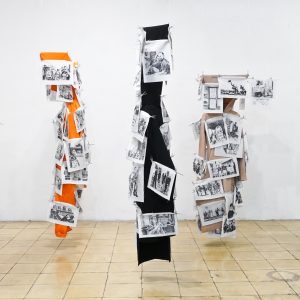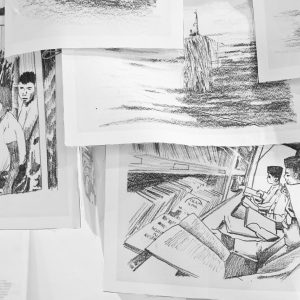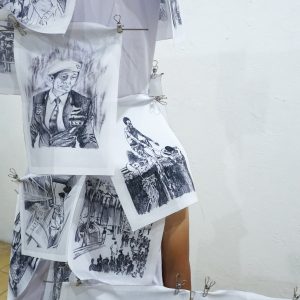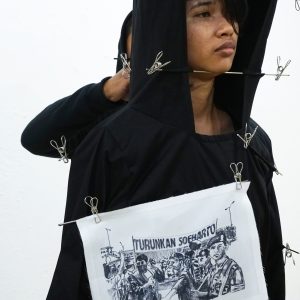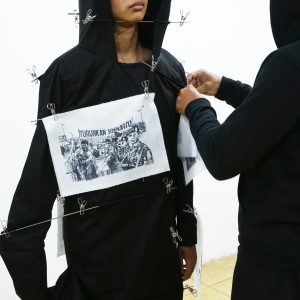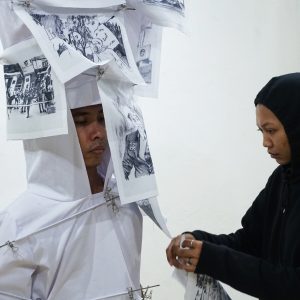‘Makna’, when translated into English alludes to ‘meaning or value’, but like so many words in Indonesian and Javanese, to a large extent, it is untranslatable in just one word. Bermakna is to carry an important meaning or to imply significance.
In my research, I want to talk about makna from an anthropological perspective. How and why do we create makna? Why do we attribute makna to objects in our material world? I focus on the pivotal role of the body and clothing in expressing makna. Last year, when I visited Bali, I witnessed a cleansing ritual forBarong and Rangda masks and costumes, led by priests in a temple in Ubud. Villagers gathered from all over Bali, to reanimate the spirits of the masks and costumes. Drawings of the characters represented in the masks were attached to the top of the costumes. The Balinese are the ultimate masters at instilling value and makna into their material world. Clothing, masks and daily objects, whether natural or man-made, are shrouded with meaning that ensures these objects have a place in the greater cosmos.
I believe that fastening a drawing to a costume is the most direct and explicit way of adding meaning or power to that garment.
This process can also be compared to an artist’s creative process, in which the artist assigns meaning or symbolises a concept in a material form to become a work of art. Visual artists generally create objects or images with hidden or surreptitious meanings and representations. Adding meaning consists of a process of symbolising or signifying, where that meaning is often multi- interpretable. In my work, I denote meaning in a very candid manner, such as a slogan with an image that is very explicit in its message.
I asked myself what actually is meaning and what gives meaning to our life? In contemplating this, I broke the concept down into five keywords, where each topic is represented by a colour:
“environment” (green),
“freedom of expression and civil rights” (black),
“religion and belief” (white),
“economy, trade” (orange),
“equality (racial and gender)” (brown).
These five keywords relate to our most important existential issues. Together with Alfin Agnuba, I searched for images from newspapers, social media and books related to the five issues. Alfin transformed the selected images into black and white drawings. During the selection process, I became acutely aware that most of the images we had collected reflected the underlying problems inherent in all of these topics.
Honestly, I didn’t realise until we had selected ahundred fifty images that these images and photos actually had all the hallmarks of pamphlets, revealing very direct messages. Many of the photos showed people in protests and demonstrations, carrying banners, boards and pamphlets with slogans.
The body that screams,
the body that protests,
the body that shows itself,
the body that makes itself heard.
What I realised is that the concept of the work and the form had actually become one. All of the images that were transformed into drawings and then printed onto fabric in advertently resemble small banners!
These drawn banners not only reflect on the five topics of environment, civil rights, equality, economics, and religion/belief, but also show specific events in time, an incident, or an occurrence in history. The performance of live models standing wearing the costumes while somebody else clips the drawn banners onto their costumes is therefore an important aspect of the Makna Project. For me, the act of clipping images to a costume is the most elemental way of vesting a sartorial style with meaning.
In reflecting on how my work was perceived by the public in Yogyakarta, the general feeling was that the work read like a pamphlet. Some critics commented that the work was very different from my previous works and labelled it as superficial and devoid of depth. This was very interesting for me because the content of the work indeed makna, by explicitly displaying meaning (makna) on the outside – the most exposed layer that is unequivocally right in your face. So, how do you create ‘meaning’ visually or as explicitly as possible with no room for any personal or symbolic interpretation?
The Makna Project will hopefully further contribute to the discourse on clothing and how clothing that is essentially related to the body also corresponds to power structures. Through clothing, the body is marked with social signals. How do we use or interpret theses signs of identity, and which ones belong to gender, territory, faith etc? How as an artist can I contribute to discuss inequity, both locally and globally, through wearable items? I believe that working with the body and clothing bridges distance that enables communication with the public on numerous issues in an intimate setting.
